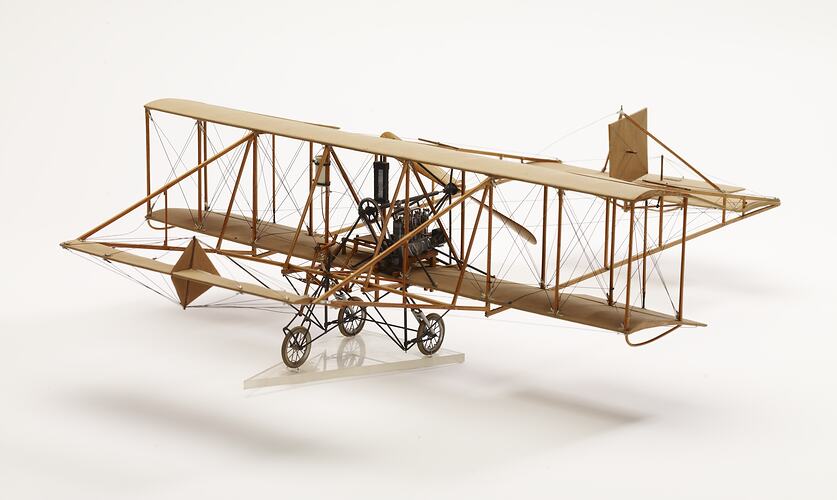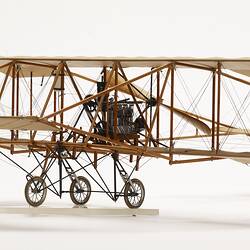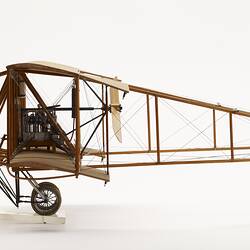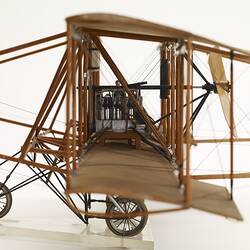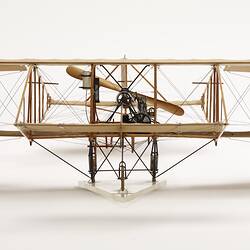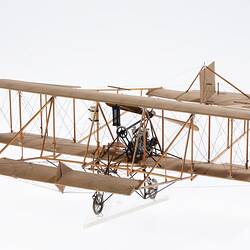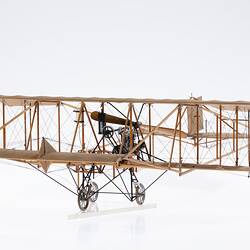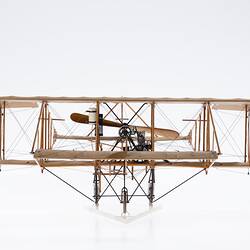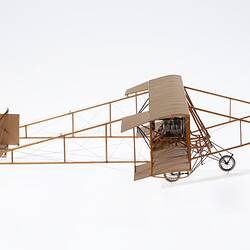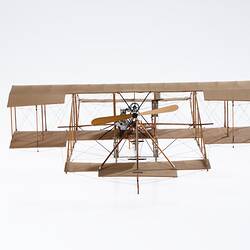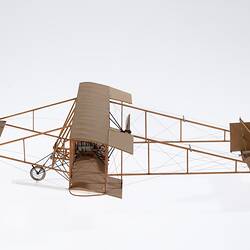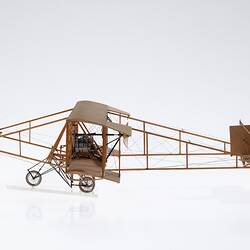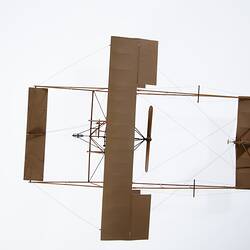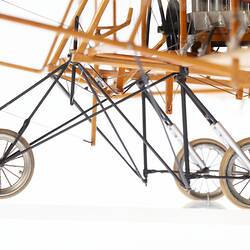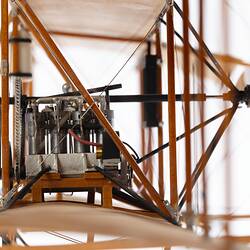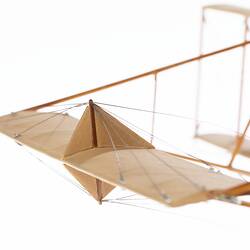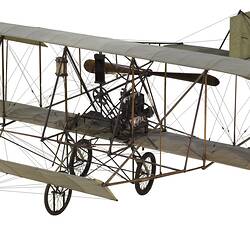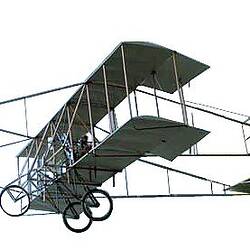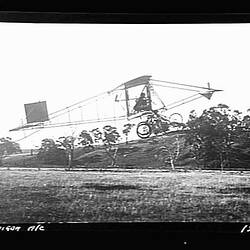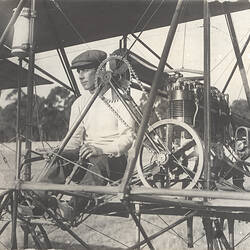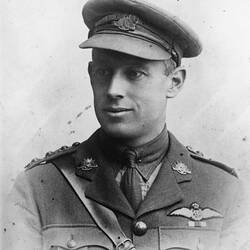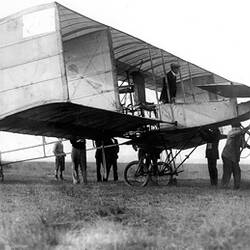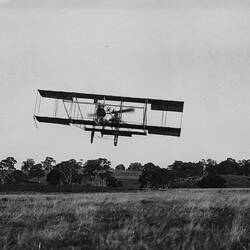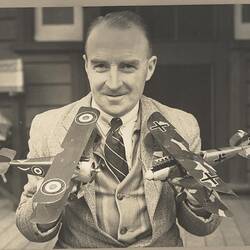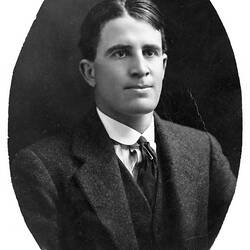Summary
Model of the Duigan Biplane made by Harold Wood in 1960.
Model History:
Model aeroplane made by Harold P. Wood in 1960 to mark the 50th anniversary of the first flight of the Duigan Biplane in 1910.
Aeroplane History:
Duigan's biplane is recognised as the first Australian designed and built aeroplane to successfully achieve powered flight. It was first flown by John Robertson Duigan on 16 July 1910 at Mia Mia, near Heathcote, central Victoria, although he did not consider this short hop to be a fully-controlled flight. Duigan regarded his flight of 196 yards on 7 October 1910 to be his first true controlled flight.
Duigan was born at Terang, Victoria, on 31 May 1882, and studied electrical and motor engineering in London, before returning to join his younger brother, Reginald, managing a family property 'Spring Plains' at Mia Mia, in central Victoria.
Inspired by the many flights of Wilbur Wright in France in 1908, Duigan built a Wright-type glider from a postcard photograph sent by a friend in Britain in late 1908 and managed to fly it in a strong wind tethered to 110 metres of fencing wire. Following this success, Duigan began work on a powered aircraft, which he first flew on 16 July 1910. Over succeeding months, further modifications and improvements were made until he managed sustained flights of up to a kilometre at heights of 30 metres. In January 1911, Duigan demonstrated his plane to newspaper reporters, and the following May he made several public flights before a crowd of 1,000 at the Bendigo Racecourse following a demonstration hop at the April 1911 Bendigo Easter Fair. Duigan's achievement is all the more remarkable for the fact that he had never seen or flown an aircraft previously and had little technical information with which to work. His first design was based on little more than a postcard of the Wright Flyer, and theory drawn from Sir Hiram Maxim's 1908 book 'Artificial and Natural Flight' and subscriptions to British aviation journals. With the exception of the engine, parts of the undercarriage and the propeller (made by John Fulton, a Carlton patternmaker), each component was made by Duigan and his brother Reginald in a rudimentary workshop on the farm.
In September 1909 the Commonwealth Government offered a £5000 prize to the inventor or designer of a flying machine suitable for military purposes. Believing his aircraft was ineligible because it could not meet the requirement of 'poising', Duigan did not submit an entry by the due date of 30 June 1910. Later, when he discovered that 'poising' had been defined simply as the capability to turn within a half-mile circle, he wrote to the Government asked for special consideration. The Commonwealth refused to accept his entry but the Defence Department requested a demonstration of the machine which took place in June 1911. It would be the last time the pioneering aircraft was flown.
Duigan returned to England later the same year to train for a flying licence with the A.V. Roe school at Brooklands in Surrey, which he obtained in April 1912. He used an A.V. Roe biplane purchased from the manufacturer but lack of engine power frustrated his efforts and he modified the engine and propeller in an attempt to improve the performance. He sold this machine soon after gaining his licence. On returning to Australia in late 1912 he brought with him the ENV engine he used in Britain which was installed in a second aircraft, a lightened copy of the A.V. Roe design using some parts purchased from A.V. Roe, that he and Reginald built at their father's home in Ivanhoe. In February 1913 the plane was extensively damaged during its first flight in a crash at Keilor that left Duigan badly shaken.
During the First World War, Duigan served with the Australian Flying Corps (the predecessor to the RAAF). On 14 March 1916, he was commissioned lieutenant in No.2 Squadron and after training was appointed to command a Flight. After further training in England he was promoted captain and served as an instructor. From December 1917 he saw action in France with No. 3 Squadron (re-named from No. 2 Squadron and No. 69 (Australian) Squadron, Royal Flying Corps)) flying an RE8 (B2271) mainly on reconnaissance patrols over the Anzac Corps front line. He was awarded the Military Cross for gallantry after a skirmish in which he and his observer Lieutenant Alec Paterson MM were attacked by four German Fokker Dr I triplanes over Villers-Bretonneux on 9 May 1918. Despite being severely wounded he regained control and made a forced landing. After recovering from his injuries he was involved in flight training in England and served briefly as the Commanding Officer of No. 7 (Training) Squadron, Australian Flying Corps in the United Kingdom until demobilisation in early 1919.
Later in life Duigan ran a motor engineering business 'Old Bridge Motors' in Yarrawonga, before returning to Melbourne in 1941 to work in the quality control branch of the Royal Australian Air Force for the duration of World War II. He died in 1951. In 1960 a memorial commemorating his pioneering flight was unveiled at Mia Mia.
Physical Description
Model of an aeroplane. Wooden framework with fabric covering over wings and cotton rigging. There's a small motor in the centre and three wheels underneath. Mounted on triangular perspex base.
More Information
-
Collection Names
-
Collecting Areas
-
Acquisition Information
Purchase
-
Maker of Item Modelled
Mr John R. Duigan, 1910
Maker of the original biplane that the model was based on. -
Inscriptions
On back tail wing: MADE BY/H.P. WOOD
-
Classification
-
Category
-
Discipline
-
Type of item
-
Overall Dimensions
640 mm (Length), 465 mm (Width), 155 mm (Height)
Dimensions of model only, excluding 6 mm thick clear Perspex stand plate. Length is measurement from tip of front elevator to rear of tail skid. Width is model wingspan. Height is overall model height when situated with horizontal pitch of fuselage as if in level flight.
-
Model Scale
1:16
-
Keywords
Aircraft, Model Aeroplanes, Innovation & Design, Models & Modelmaking, Aviation
